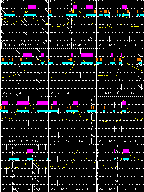
Date Time Imp Locus Yohkoh coverage Eruptive commentary 4-NOV-97 05:58 X2.1 2B Full-frame data - (from 06:10:02) 6-NOV-97 11:55 X9.4 S19E64 Good coverage faint ejecta to SW 27-NOV-97 13:17 X2.6 N19W64 Good coverage strong ejecta >13:13 to SE 23-APR-98 05:55 X1.2 S19E105 Good coverage ejecta, fast and slow, to E 27-APR-98 09:20 X1.0 2B S19E54 Rise phase only "slow LDE" with ejecta to E 2-MAY-98 13:42 X1.1 3B S15W15 Rise phase only jet >13:36 to NE 6-MAY-98 08:09 X2.7 S16W67 Good coverage Moreton wave? + loop ejection 18-AUG-98 08:24 X2.8 No coverage - 22-NOV-98 06:42 X3.7 S30WL Main phase only Ejecta to SW (>06:39) 22-NOV-98 16:23 X2.5 S29WL Late rise, peak Ejecta to SW 23-NOV-98 06:44 X2.2 S30WL Decay phase - 24-NOV-98 02:20 X1.0 S30WL From peak only - 28-NOV-98 05:52 X3.3 N17E46 Good coverage Complex ejection to E
The following plots also summarize the Yohkoh coverage graphically, with a similar format as for the weekly GOES plot shown at the top of this page. The yellow line gives the GOES low-channel light curve, and the tick marks show the SXT image times, with purple indicating flare mode. At the time of writing, we had complete databases for all of the events except for one. In the table above, "good coverage" means that flare mode extended across the impulsive phase.

These X-class flares give us a good opportunity to ask this question where the answer is likely to be "YES". In fact, (Yohkoh) obtained good coverage for 9 of the 13 X flares, where "good" is defined as coverage of the impulsive phase The Yohkoh new-cycle data on major flares thus confirm the Shibata et al. conclusions, namely that ejection is omnipresent. The new-cycle flare data are better than the old data for this purpose, because SXT now runs an "ejection special" program that provides good cadence with large fields of view (10 arc min and 5 arc min), so that we can make a more evenhanded survey for ejectivity.
Of course, simply because a flare ejects matter does not meant that large-scale reconnection has anything to do with energy release! Most of these ejecta are faint, many go at odd angles relative to the local vertical, and in no case do we see obvious inflow as a source of reconnection energy - see the critique of model predictions (.ps file) by Hudson and Khan for more discussion.